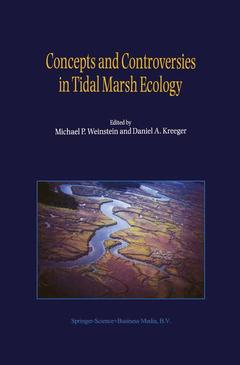Description
Concepts and Controversies in Tidal Marsh Ecology, Softcover reprint of the original 1st ed. 2000
Coordinators: Weinstein M.P., Kreeger Daniel A.
Language: English
Subject for Concepts and Controversies in Tidal Marsh Ecology:
Keywords
Ecology; Fauna; Sediment; algae; benthic; biogeochemical cycles; ecosystem; ecosystems; environment; fisheries; macrophytes; nutrient cycling; vegetation; wetland
Concepts and Controversies in Tidal Marsh Ecology
Publication date: 12-2014
875 p. · 15.5x23.5 cm · Paperback
Publication date: 12-2014
875 p. · 15.5x23.5 cm · Paperback
Concepts and controversies in tidal marsh ecology
Publication date: 10-2000
875 p. · 15.5x23.5 cm · Hardback
Publication date: 10-2000
875 p. · 15.5x23.5 cm · Hardback
Description
/li>Contents
/li>
In 1968 when I forsook horticulture and plant physiology to try, with the help of Sea Grant funds, wetland ecology, it didn?t take long to discover a slim volume published in 1959 by the University of Georgia and edited by R. A. Ragotzkie, L. R. Pomeroy, J. M. Teal, and D. C. Scott, entitled ?Proceedings of the Salt Marsh Conference? held in 1958 at the Marine Institute, Sapelo Island, Ga. Now forty years later, the Sapelo Island conference has been the major intellectual impetus, and another Sea Grant Program the major backer, of another symposium, the ?International Symposium: Concepts and Controversies in Tidal Marsh Ecology?. This one re-examines the ideas of that first conference, ideas that stimulated four decades of research and led to major legislation in the United States to conserve coastal wetlands. It is dedicated, appropriately, to two then young scientists ? Eugene P. Odum and John M. Teal ? whose inspiration has been the starting place for a generation of coastal wetland and estuarine research. I do not mean to suggest that wetland research started at Sapelo Island. In 1899 H. C. Cowles described successional processes in Lake Michigan freshwater marsh ponds. There is a large and valuable early literature about northern bogs, most of it from Europe and the former USSR, although Eville Gorham and R. L. Lindeman made significant contributions to the American literature before 1960. V. J.
Foreword. Dedication. Preface. Retrospective on the Salt Marsh Paradigm. Tidal marshes as outwelling/pulsing systems; E.P. Odum. Salt marsh values: etrospection from the end of the century; J.M. Teal, B.L. Howes. Sources and Patterns of Production. Role of salt marshes as part of coastal landscapes; I. Valiela, et al. Spatial variation in process and pattern in salt marsh plant communities in eastern North America; M.D. Bertness, S.C. Pennings. Eco-physiological controls on the productivity of Spartina alterniflore; I.A. Menselssohn, J.T. Morris. Community structure and functional dynamics of benthic microalgae in salt marshes; M.J. Sullivan, C.A. Currin. Structure and productivity of microtidal Mediterranean coastal marshes; C. Ibañez, et al. Development and structure of salt marshes: community patterns in time and space; A.J. Davy. Fate of Production Within Marsh Food Webs. Microbial secondary production from salt marsh-grass shoots, and its known and potential fates; S.Y. Newell, D. Porter. Trophic complexity between producers and invertebrate consumers in salt marshes; D.A. Kreeger, R.I.E. Newell. Trophic linkages in marshes: ontogenetic changes in diet for young-of-the-year mummichog, Fundulus heteroclitus; K.J. Smith, et al. Habitat Value: Food and/or Refuge. Factors influencing habitat selection in fishes with a review of marsh ecosystems; J.K. Craig, L.B. Crowder. Salt marsh ecoscapes and production transfers by estuarine nekton in the southeastern U.S.; R.T. Kneib. Salt marsh linkages to productivity of penaeid shrimps and blue crabs in the northern Gulf of Mexico; R.J. Zimmerman, et al. Ecophysiological determinants ofsecondary production in salt marshes: a simulation study; J.M. Miller, et al. Salt marsh ecosystem support of marine transient species; L.A. Deegan, et al. Biogeochemical Processes. Benthic-pelagic coupling in marsh-estuarine ecosystems; R.F. Dame, et al. Twenty more years of marsh and estuarine flux studies: revisiting Nixon (1980); D.L. Childers, et al. The role of oligohaline marshes in estuarine nutrient cycling; J.Z. Merrill, J.C. Cornwell. Molecular tools for studying biogeochemical cycling in salt marshes; L. Kerkhof, D.J. Scala. Nitrogen and vegetation dyamics in European salt marshes; J. Rozema, et al. Modeling Nutrient and Energy Flux. A stable isotope model approach to estimating the contribution of organic matter from marshes to estuaries; P.M. Eldrige, L.A. Cifuentes. Types of salt marsh edge and export of trophic energy from marshes to deeper habitats; G. Cichetti, R.J. Diaz. Silicon is the link between tidal marshes and estuarine fisheries: a new paradigm; C.T. Hackney, et al. Tidal Marsh Restoration: Fact or Fiction? Self-design applied to coastal restoration; W.J. Mitsch. Functional equivalency of restored and natural salt marshes; J.B. Zedler, R. Lindig-Cisneros. Organic and inorganic contributions to vertical accretion in salt marsh sediments; R.E. Turner, et al. Landscape structure and scale constraints on restoring estuarine wetlands for Pacific coast juvenile fishes; C.A. Simenstad, et al. Ecological Engineering of Restored Marshes. The role of pulsing events in the functioning of coastal barriers and wetlands: implications for human impact, management and the response to sea level rise; J.W. Day, et al. Influences of vegetation and abiotic environmental f
© 2024 LAVOISIER S.A.S.




